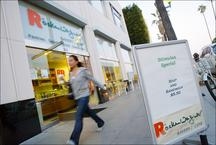
CITYWIDE — It’s a good time to shop if you have money.
Kurt Peterson, a shopper from Washington D.C half-jokingly asked, “We’re in a recession?”
“My [shopping] habits have been the same, which is sad,” Peterson said. “I know CNN two weeks ago said you have to play depression, but I’m hitting Melrose this afternoon.”
Most retailers are starting to experience what some analysts are calling the new depression during this current economic slump. As consumer spending trickles to a slow drip, shops around Santa Monica are slashing prices to attract elusive customers.
“We’re trying to increase sales especially now with the slow economy,” Tyler Cummings, manager of sports store Active, said. “We’re doing anything you can to bring anybody in.”
Active is currently cutting prices up to 75 percent on certain retail items.
The food service industry has also been affected by this recession rather harshly. Many restaurants aren’t attracting as many customers during lunch time, Peterson said. Rockenwagner Bakery is offering a “stimulus special,” which is a small sandwich and soup for $5.50 during lunch hours. The special’s name wasn’t put in place because of the recession per se, rather it’s a clever and relevant way to garner attention for a newly opened restaurant, Jose Lopez, Rockenwagner Bakery’s manager, said.
“Not everyone wants to spend eight or 10 dollars for lunch,” Lopez said. “This will fit people’s budgets.”
February is always a slow month for all kinds of sales, but this year is especially bad, Cummings said.
During this time of year, locals traditionally curb their shopping and tourists fill out sagging sales, he said. This year is different.
Tourists aren’t spending their foreign cash with typical vigor.
Even with all the discounts, buying clothes here is very expensive, Max Ovalle, a Chilean shopper, said.
“I always try to look for the sales, but they aren’t as good as some years ago,” Ovalle said.
According to The Economist’s Big Mac Index, Chilean currency was 29 percent undervalued to the dollar in January 2009.
“[There’s been] a large depreciation, and a Chilean shopper here would certainly notice,” Aris Protopapadakis, associate professor, of finance and business economics at USC Marshall School of Business, said in an e-mail.
The dollar also appreciated against most currencies, including the Euro, later on in 2008, Protopapadakis said. Even though the dollar is showing strength, retailers are presenting special promotions to compete with each other and stay operating, Lars Perner, assistant professor of clinical marketing at USC Marshall School of Business, said.
Patagonia has an annual winter sale, but this year the company is discounting its old clothing line from 40 to 60 percent. This is more than the normal 30 to 50 percent, Bryan Hays, Patagonia’s Main Street store manager said.
“We’re getting a good turnout this year,” Hays said. “This year in particular, people are being conscientious when they make purchases.”
Most consumers are now waiting patiently for items to go on sale instead of buying them immediately, Hays said.
The cost of clothing, food and consumer durables won’t permanently drop because it allows price discrimination between certain types of buyers, Perner said.
This separates people that are willing to hunt for bargains and haggle from those who aren’t.
“For high ticket items there is much more bargaining going on,” Perner said. Bargaining occurs more often during expensive purchases, such as cars and high definition televisions, he said.
Over the past few years new car sales are down, but high-end dealerships aren’t reducing their prices dramatically, Chris Pass, general manager at Simonson Mercedes Benz, said.
“Your not going to see a fire sale at Tiffany’s and your not going to see one at Mercedes Benz,” Pass said.
There isn’t a particular policy of negotiating prices at Simonson, but the company always is adjusting inventory and interest rates to accommodate the market, Pass added.
For the most part, retailers and shoppers of smaller purchases around Santa Monica don’t engage in bargaining, either. Active’s Cummings said he wouldn’t accept more than a 10 percent cost reduction off a listed price.
“I don’t mind if someone’s a little bit short and helping them out,” Cummings said.
Most American shoppers don’t feel comfortable bargaining with retailers. “It’s set price here, you can’t [bargain],” Kristin Rottina, a shopper from Los Angeles said.
There is a simple bottom line while shopping during this economic climate, Kourtney Jones, a Midwestern shopper said.
“I just look for things that are already on sale that I can afford,” Jones said.
news@www.smdp.com








